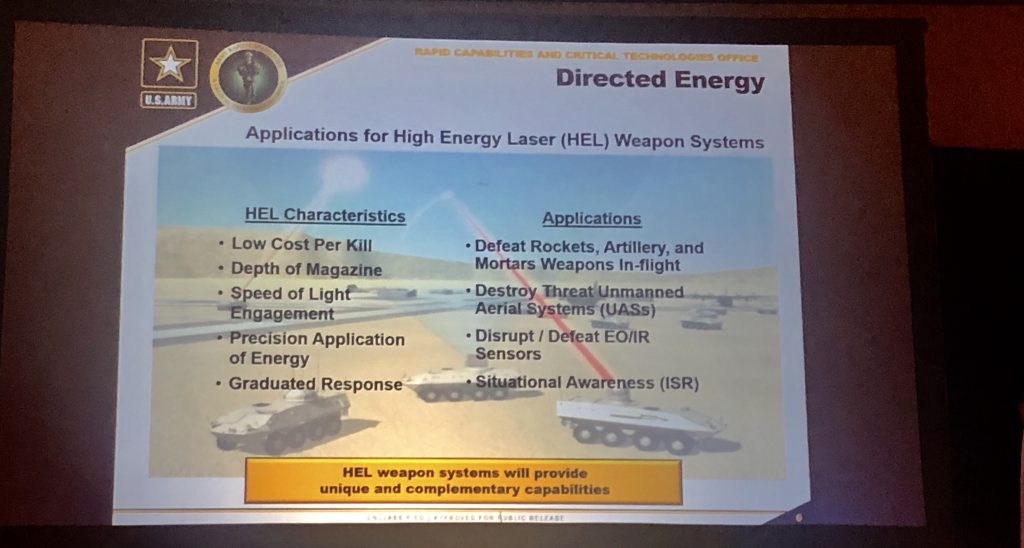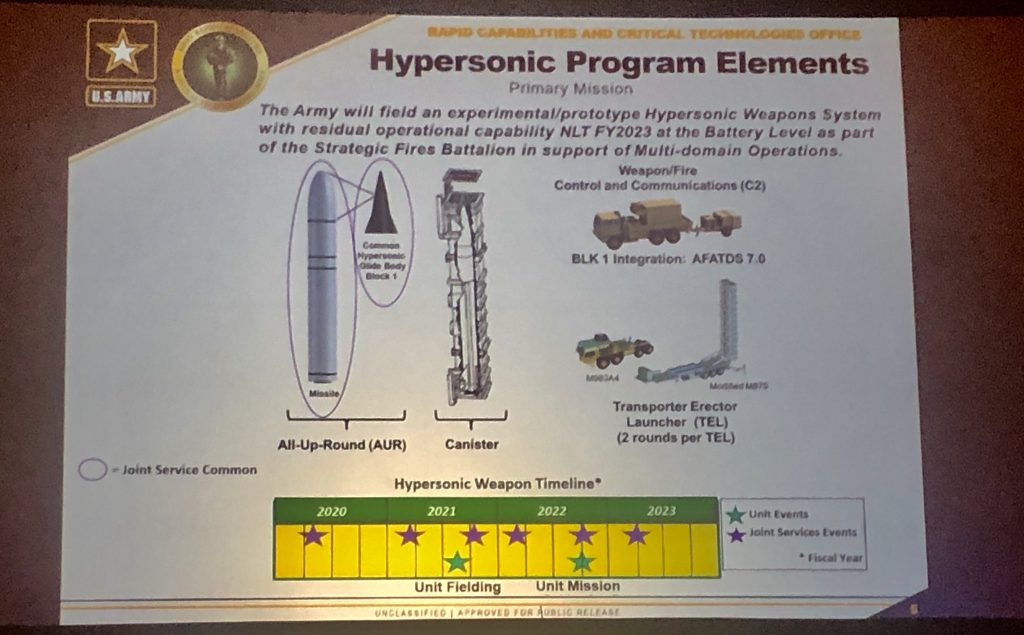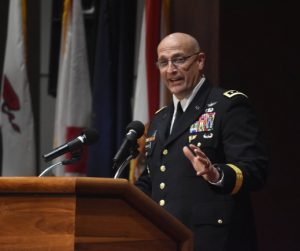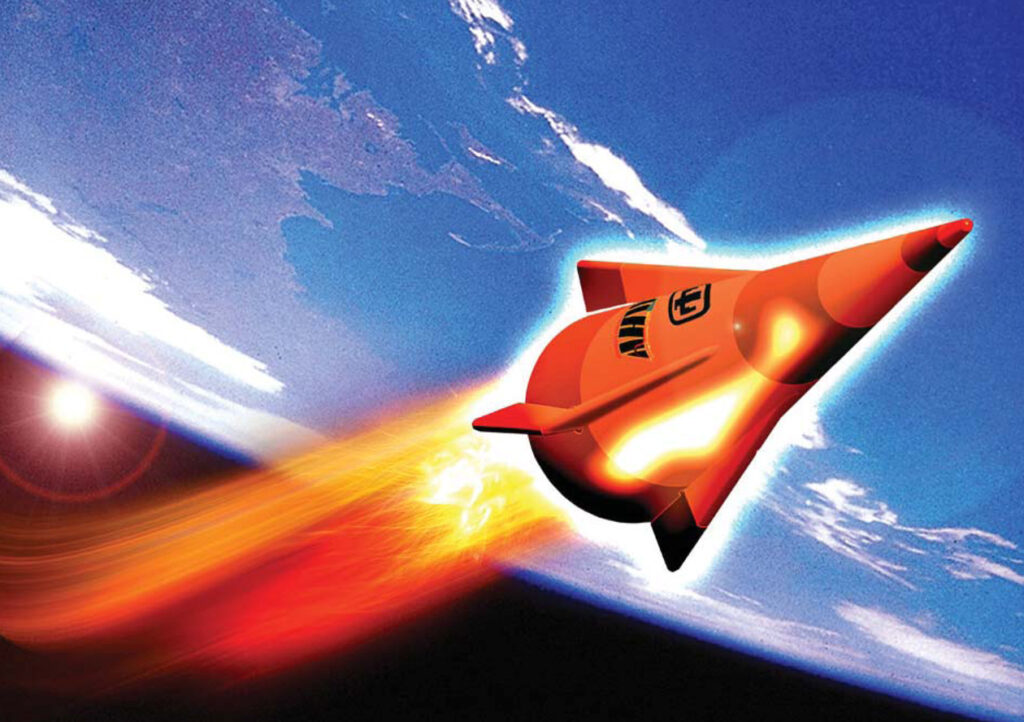Army Moves Out On Lasers, Hypersonics: Lt. Gen. Thurgood
Posted on

LANPAC HONOLULU: Earlier this week, Army leaders approved a detailed plan to get high-powered microwave and laser weapons into the hands of soldiers, advancing rapidly in parallel to development of hypersonic missiles, Lt. Gen. Neil Thurgood said here. But, he warned the AUSA conference, directed energy is “not the panacea of all things.”
“Clearly, we can accelerate directed energy into our formations,” said Thurgood, who as head of the service’s recently reorganized and beefed-up Rapid Capabilities and Critical Technologies Office (RCCTO, manages the service’s most high-tech, high-priority programs: directed energy, space, and hypersonics. (More on hypersonics below). The Army’s especially interested in taking out incoming rockets, artillery, mortar rounds, and small drones with electrically-powered weapons that cost pennies per shot instead of expensive one-use interceptors. But lasers and microwaves have real limits.
For example, they don’t work well against swarms, where lots of small targets are converging on you at once. ”You want to kill a swarm of things — whatever that thing is — lasers are not really a swarm-killing tool. They can kill things fast but they can’t kill a swarm of things fast enough.”
That said, he continued with a chuckle, “if you’re in my world, I’m always thinking about Private Thurgood. Killing one thing is better than killing nothing.”
The Army plans to test a roughly 50-kilowatt laser on an 8×8 Stryker armored vehicle by 2021, followed by a 100-kW one on a heavy HEMTT truck.
Thurgood provided few other details about the DE plan beyond the chart at the top of this story and the fact Army leaders approved it. I pressed him for details after he spoke, and got a simple and direct “I’m not going to discuss that.”
Joint Hypersonics
The other program Thurgood discussed is the high-profile Army hypersonics program. He confirmed that the Army will supply the glide vehicle, made by Sandia National Laboratory, to the Navy and Air Force, as well as to the Army, which has led the program.
Successfully tested in 2012, the Advanced Hypersonic Weapon (AHW) concept for Army Space and Missile Defense Command was launched from the Kauai Test Facility in Kauai, Hawaii, using a three-stage booster system developed at Sandia.
Part of his job, Thurgood noted, is making sure the vehicle makes it from the S and T world of Sandia into the hands of troops: “My job is to bring that glide body into commercial production.”
Starting in 2021, the Army will test-fire glide bodies every six months. Before that, a fully assembled canister for launching the glide vehicle will be delivered to the first rocket artillery unit so they can train to load and reload the 400-inch long canister on the Transporter Erector Launcher, he said: “They’ll be able to do everything they need to do except launch.”

The Navy and Army are building relatively similar systems, though the Navy system may also be launched from submarines, as well as surface ships.
The Air Force’s “Hacksaw” (HCSW, Hypersonic Conventional Strike Weapon) program, for which Lockheed Martin is building a prototype for up to $928 million, does not require a launcher since the missile will be carried by an airplane.
One of the things that hasn’t been entirely clear about the Conventional Prompt Global Strike effort is whether each service had a separate program or if it was an OSD-directed plan. Well, from what Thurgood told me after his talk, OSD oversees the three efforts with a sort of board of directors, while each service does have a separate program. Altogether, the US military is pursuing roughly half-a-dozen hypersonics effort, including one by DARPA.
In the best part of his talk, Thurgood addressed a sensitive issue. “This weapons platform is not long range artillery. It is a strategic weapon for leaders to use at the strategic level,” he noted. “Just so we’re clear, when I gave the brief to the board of directors, I said gentlemen, let me make sure I understand what you’re asking me to do. You’re going to ask me to build a spaceship that we’re going to allow a captain in a battery to launch. That right? I’m all in!”
Thurgood clarified that all the highly complex mission planning and the final decision to launch would be in the hands of senior leaders. But the Army’s still wrestling with how to organize and operate in long-range missile warfare, which is a crucial part of its emerging combat concept called Multi-Domain Operations.
The Army’s No. 1 modernization priority is an array of Long-Range Precision Firepower weapons, from rocket-propelled, precision-guided howitzer shells to hypersonics firing over 1,000 miles. The idea is to provide Army units fire support even when advanced anti-aircraft defenses keeps US air support at bay — and to use Army surface-to-surface missiles to destroy those anti-aircraft defenses, opening the way for the Air Force to move in. Until the Air Force arrives to clear the skies, the Army will also need to protect itself against enemy drones, which is driving the investment in lasers and microwaves..
This idea of the Army leading the way is a reversal of the traditional relationship, in which airpower precedes and supports ground forces. It also opens up new opportunities for escalation, accidental and otherwise, in a world where the INF Treaty banning long-range land-based missiles has gone away.
Sydney Freedberg contributed to this story.
Subscribe to our newsletter
Promotions, new products and sales. Directly to your inbox.


